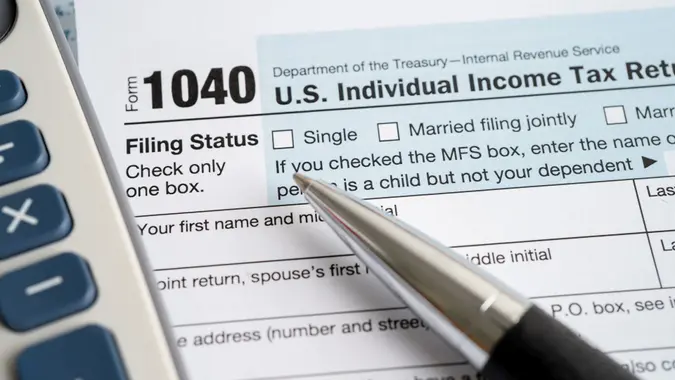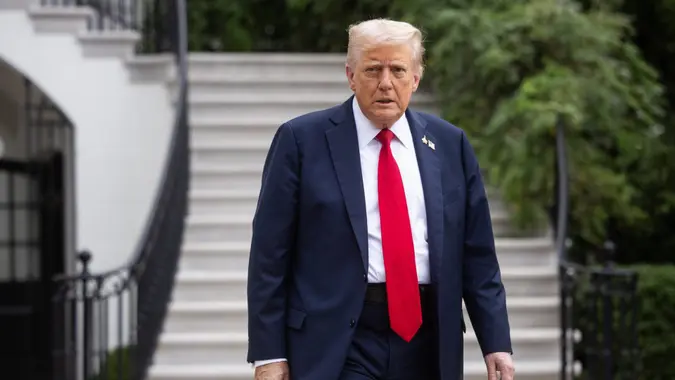I’m a Tax Expert: 4 Predictions I Have for Trump’s Tax Plan in 2025

Commitment to Our Readers
GOBankingRates' editorial team is committed to bringing you unbiased reviews and information. We use data-driven methodologies to evaluate financial products and services - our reviews and ratings are not influenced by advertisers. You can read more about our editorial guidelines and our products and services review methodology.

20 Years
Helping You Live Richer

Reviewed
by Experts

Trusted by
Millions of Readers
President Donald Trump’s second term has been defined by volatility and uncertainty. Early on, he proposed replacing income taxes with tariffs, and, after granting a few exemptions and deadline extensions in the first few months of his term, Trump has laid down the gauntlet with tariffs across the board.
GOBankingRates spoke with two tax experts to gauge the economic impact of Trump’s tariff policies and how they can impact taxes moving forward.
Tariffs Are Unlikely To Replace Income Taxes
George Carrillo is the CEO of the Hispanic Construction Council (HCC). He is a democratic candidate for governor who has a first-hand understanding of how federal economic and trade policies impact the everyday lives of working families.
He explained the hurdles Trump faces when it comes to replacing income taxes with tariffs. “Tariffs are an inadequate substitute for income taxes as a primary revenue source. The financial data from 2023 highlights this impossibility.”
The Congressional Budget Office reported $4.4 trillion in revenue for the federal government in 2023. The largest source of that revenue — accounting for $2.2 trillion, or 50% — was individual income taxes. The same year, Statista reported, tariffs accounted for $80 billion of the total revenue, or just under 2%.
“This glaring disparity illustrates why tariffs, even if increased, cannot realistically fund federal operations on their own,” Carrillo explained.
Trump May Cut Taxes
Carrillo believes Trump will extend the Tax Cuts and Jobs Act (TCJA) in an effort to reduce income taxes. However, he is critical that Trump’s policy will have an outsized benefit for high-net-worth individuals.
“[The TCJA] involves significant reductions in corporate tax rates and marginal relief for individuals across different income groups,” he explained. “If extended, the wealthiest 1% could save substantial amounts, averaging $70,000 annually, while middle-class taxpayers see modest relief of approximately $1,000 per year.”
Any income tax cuts will have an outsized benefit for the people who pay the most income taxes. Someone who pays $100,000 per year in income taxes has more to gain from income tax cuts than a low-income earner who is paying less than $1,000 in income taxes. Carrillo believes the TCJA policies will expand class disparities.
Short-Term Pain for Long-Term Gain
Even Trump’s advocates are acknowledging that tariffs will bring short-term pain. Brenda Christensen is the CEO of Stellar Public Relations. She is also an Inc. 500 Entrepreneur who has a firm grasp of taxes and economic policy. Christensen has previously worked with Trump, giving her a better perspective on his long-term plans.
“While there are short-term tariff hits like price increases — especially for durable goods like automobiles, appliances and technology hardware — markets will stabilize and rebound by June,” she said.
She also explained that the U.S. can make itself less reliant on China through tariffs and why it’s essential for the country to follow this route.
“The current market disruption is a necessary reset as Trump sets the foundation for U.S. economic independence and long-term prosperity,” she explained. “The bigger picture is that China is facing a population collapse, which is unsustainable. This is one of the critical levers in the U.S. that is driving us to reclaim our role as a global manufacturing leader.”
She pointed out that this plan “aligns with initiatives to secure China-like resources — rare earth, etc. — from Canada and Greenland to prepare for the eventual collapse of China.”
The population collapse concerns are warranted. China’s population fell for the third consecutive year in 2024, Reuters reported, and China’s fertility rate has been well below the replacement level for decades. Christensen argued that relying on a declining population on the verge of collapse for U.S. manufacturing may not be the best approach.
The Tax Code Could Get Simpler in the Future
Christensen believes Trump is on the path to replacing the IRS with the External Revenue Service. She said the tax code would be easier to understand and explained some of the other policies Trump could enforce, including a national sales tax.
“Looking ahead, I predict further efforts to not only simplify the tax code but incentivize domestic manufacturing through credits and introduce new forms of consumption-based taxation (flat tax) to replace traditional income taxes — all part of the long game and securing the U.S. as the dominant world power.”
Editor’s note on political coverage: GOBankingRates is nonpartisan and strives to cover all aspects of the economy objectively and present balanced reports on politically focused finance stories. You can find more coverage of this topic on GOBankingRates.com.
More From GOBankingRates
 Written by
Written by  Edited by
Edited by 

























